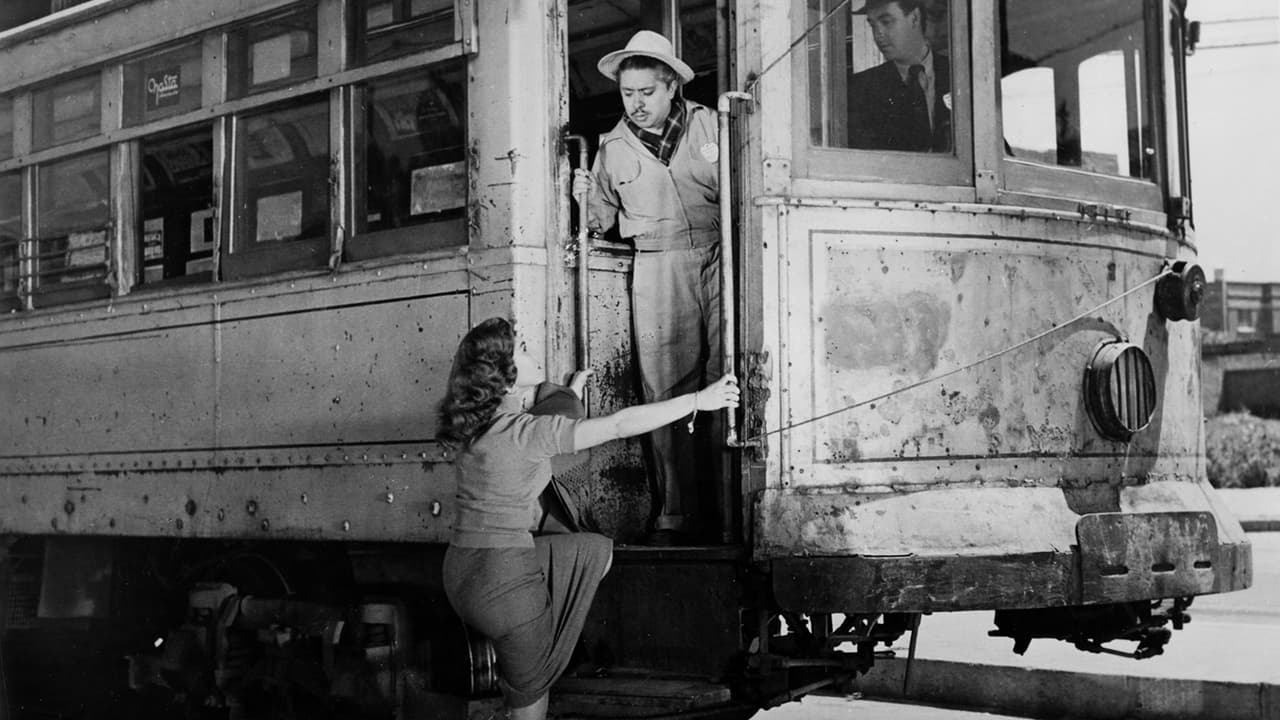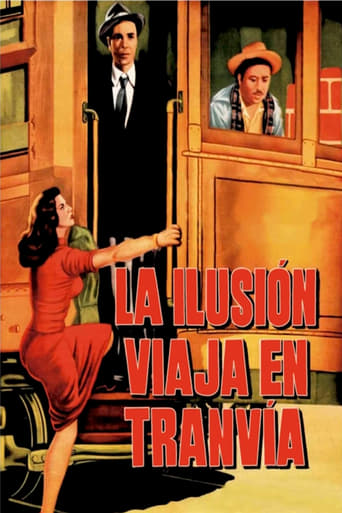Hellen
I like the storyline of this show,it attract me so much
Diagonaldi
Very well executed
Freaktana
A Major Disappointment
CrawlerChunky
In truth, there is barely enough story here to make a film.
Art Stukas
Another of Bunuel's Mexican films wherein he tells the picaresque tale of two bumbling streetcar workers who, after swiftly repairing a streetcar that had been deemed obsolete (and a few beers), decide to steal it for one last spin. Their adventures take them across Mexico City and in contact with a solid cross-section of the public, including slaughterhouse workers who gleefully (and surreally) hang huge slabs of meat (and heads) from the roof of the tram. Perhaps there is a metaphor or a moral here – certainly Bunuel takes the opportunity to poke fun at corporate capitalism – but any message takes a back seat (ahem) to the overall good time on offer. I particularly enjoyed the staging of Lucifer's banishment from Heaven and Adam and Eve's departure from Eden at the local festival, not unlike the amateur theatrical performances in Renoir's The Rules of the Game in their wacky but creepy surrealism.
MARIO GAUCI
On first viewing – again, as part of that 2007 Bunuel/NFT retrospective – I had found this to be an enjoyable but rather insubstantial comedy; on this revisit, my opinion has not changed about this minor work from the celebrated Spanish director. Indeed, I was surprised to learn (from the opening credits) that Bunuel was not even involved in the screen writing process of this one – although, I do not think it is a coincidence that the film's comic highlight is a wonderful "Garden of Eden" pageant sequence early on (in which the three protagonists playing God, Adam and a swim-suited Eve, are tormented by a heavily-horned Lucifer wearing a shirt sporting the word "serpent"!).The film is fairly similar to Bunuel's earlier (and superior) Mexican 'road movie' ASCENT TO HEAVEN aka Mexican BUS RIDE (1952) in that it is set, for the most part, on a means of public transportation. Besides, its plot line of an ancient vehicle being taken for one last ride before ending up in a scrapheap also harks back to such classic comedies as Harold Lloyd's SPEEDY (1928) and Ealing's practically contemporaneous THE TITFIELD THUNDERBOLT (1953). Incidentally, Bunuel's cinematic idol Fritz Lang, made his own railroad movie that same year: the noir-ish melodrama HUMAN DESIRE (which I own but have yet to watch) – itself a remake of Jean Renoir's LA BETE HUMAINE (1938).As usual with Bunuel's films from this period, it starts with a faux-documentary narration and, in this case, amusingly concludes on a "this was just one of a thousand stories" line a' la Jules Dassin's seminal noir THE NAKED CITY (1948). The director's depiction of the downtrodden Mexican villagers' everyday life (culminating in a riot when the smuggling of corn as fertilizer is accidentally discovered by one of the bumbling protagonists) brought on comparisons with Italy's then-current Neo-realist movement – something which Bunuel readily denied. Indeed, while the story could well have been inspired by a similarly liberating ride through the streets of Paris made by the Surrealist movement in 1931, the truth is that the film was commissioned by a nascent Mexican public transport company to counter the bad press caused by an accident they had had the previous year!Two regular actors from Bunuel's work in Mexico – the lovely Lilia Prado and the amiably rotund Fernando "Mantequilla" Soto (as a streetcar conductor named Tarrajas) – also appear here, alongside Carlos Navarro (as Prado's streetcar mechanic boyfriend) and Agustín Isunza (as Papa Pinillos, a nosy ex-railroad employee). The perennially frustrated attempts of the two company employees to take back the streetcar they stole before its absence is discovered is paralleled by Papa Pinillos' constantly dismissed claims of this very theft to his pompous former employers.Among the commuters who inadvertently get to make use of the runaway streetcar (the film's alternate title) are: a schoolmistress with her classroom of unruly children who are, eventually, stranded on a film set (an orphan in their midst is told that the long-legged starlet being made-up is his long-lost mother!); two elderly ladies carrying a statue of Jesus Christ in "Ecce Homo" guise; a couple of 'penniless' politicians; a clueless American tourist who mistakes the protagonists' reluctance to accept fare – which would have aggravated their misdemeanor – as "Communist" behavior (possibly, former party member Bunuel's barbed comment on the "Red Scare" then currently scourging through Hollywood); and, most memorably, slaughterhouse workers carrying their slabs of meat along as 'luggage'! I cannot forget to mention that, very early on in the film, there is also a throwaway laugh-out-loud moment when a billboard reads: "Well…so what?"P.S. Surprisingly enough, the film played without a glitch on my Philips DVD player which, usually, has a lot of trouble dealing with DivX files!
Claudio Carvalho
In the 50's, in Mexico, the streetcar mechanic Juan Godinez (Carlos Navarro) and the pilot Tarrajas (Fernando Soto) become upset when they are informed by their supervisor that the streetcar number 133 will be decommissioned. They go to a party and late night, they get drunk and decide to borrow the streetcar for one last spin for fun, without charging the passengers. Completely wasted, they sleep in the streetcar and on the next morning, they get in troubled and weird situations while trying to return the vehicle to the garage."La Ilusión Viaja en Tranvía" is a minor movie of Buñuel. This naive comedy presents jokes with religion; criticizes the inflation, the corruption and the tough condition of the poor people in Mexico city; exposes the ridiculous behavior of henchman, represented by the retired Papa Pinillos (Agustín Isunza). Unfortunately, the comedy is not funny, with the exception of the scenes with the villain Papa Pinillos, responsible for the best and funniest moments of the film. My vote is five.Title (Brazil): "A Ilusão Viaja de Bonde" ("The Illusion Travels by Streetcar")
Aw-komon
Don't think this is a light film just because it's a comedy made with Mexican actors. There are many layers here and much clever satire not only on the Mexican society of that period but (as always with Bunuel) human behavior in general. The ironic detachment of the director is never so far as to render these characters unrealistic caricatures; far from it, they're as fully real as anything in 'Los Olvidados,' except here things are examined from a much less cynical angle. Comedy is, after all, the flipside of tragedy and if comedy sells better, you only run the risk of being misunderstood by most of the audience on a very superficial level; on a deeper level even the commonest comedy fan implicitly gets the message. This film is in many ways similar in its structure and tone (and on a deeper level even in subject matter) to Alexander Payne's 'Citizen Ruth' and 'Election' or Todd Solondz's 'Welcome to the Dollhouse.' Except here, Bunuel shows less 'cruelty' than in most of his other films; here he tries his hand at an homage to certain great American comedies of the '30s and '40s which managed to use comic misadventures to veil serious messages underneath. The difference is that Bunuel consciously planned and fully intended this result whereas the Americans may have just ended up there unexpectedly and unconsciously.

